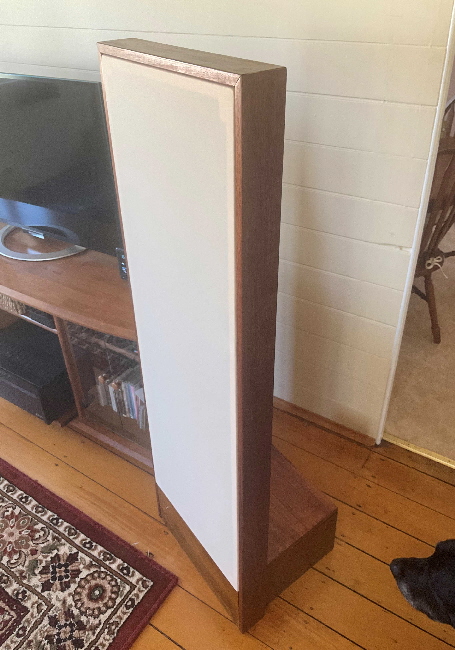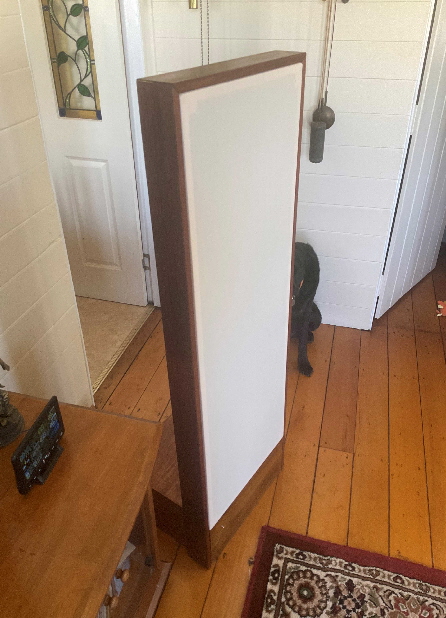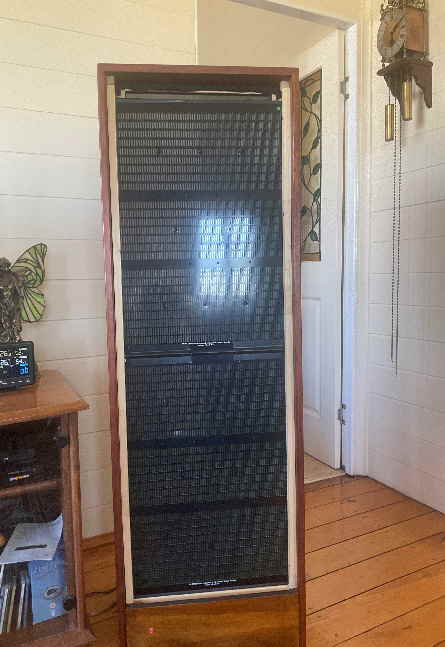Geoff Reviews ESL IV

I first heard electrostatics many decades ago as a youngster just starting work. I was drooling over the gear in a dealers demo room when the salesman said “sit here and listen to these Quads”. I was blown away. I had never heard anything like the sound that came out of what looked like electric room heaters, but they were way out of my reach at several months wages! This started a lifelong interest in audio and speaker building.
Now I am well into my retirement years I decided to indulge myself in a top quality stereo system so did some research on the internet. It was clear that commercially made electrostats are still very expensive. I searched for kits and fortunately the E R Audio web site came up.
I contacted Rob Mackinlay and learned he was developing the ESL IV. I placed an order for 4 ready built panels and power supplies. Over the next few months, Rob sent me frequent updates with photos on progress and answered my many questions.
The panels and power supplies arrive very well packed and I commenced making the frames. I am definitely not a woodworking expert and kept construction basic and simple.
I sourced all wood and hardware from Bunnings (an Australian hardware chain, edited by Rob) and grille cloth from Jaycar. Side cheeks are lengths of Merbau decking. This wood is very strong and dense and is also used for furniture. 20 X 20 X 3 aluminium angle was screwed and glued to side cheeks. Base box simple with butt joints screwed and glued. I used Liquid Nails Clear which is incredibly strong and sets like concrete. The grill cloth frames have aviary wire mesh attached for an earthed safety screen. (We recommend an earthed screen is used for safety reasons, Rob)
I mounted each speaker on 3 small castors. I know castors are not ideal for stability but I wanted to be able to move easily to try different locations. I mounted front castors on blocks to give panels a small back tilt, which I thought improved sound. I have, as yet, not added back braces as I am not sure if needed.
I am using an Onkyo TXNR474 5.1 receiver in 2.0 mode. The amp is advertised at 135 Watts per channel and is a high current amp capable of driving 4 Ohm speakers. This receiver drives the electrostats well and I do not think a really expensive amp is required. A budget home theater receiver may be problematic if it is not a high current amp and not specified to be able to drive 4 Ohm speakers.
So, how do they sound? If I had to describe these speakers in one word, it would be “honest”. You get out what you put in. Feed them with a well recorded, well engineered high quality digital file and they can sound absolutely stunning. Clarity and attack is amazing. The human voice can be startlingly lifelike on a good recording. Feed them with a mediocre recording and this is exactly how they will sound. Unfortunately, many modern recordings are engineered to sound good on iPods and car radios etc. and this over-engineering is obvious with these speakers. This is not a criticism of the speakers, rather a criticism of the recording studio. Once one has heard a good recording through these speakers one realises just how amazing high accuracy speakers, like these electrostats, can sound. After this experience, many dynamically squashed recordings sound disappointingly flat and lifeless in comparison. These speakers deserve to be fed the best quality recording possible. There are some artists who seem to care, and put out good recordings.
Bass is surprisingly good. Bass is tight and musical down to 40Hz but not much below, although this may be due to room dimensions. I tried my sealed box 12 sub but rapidly decided this was not a good idea, it just did not sound right. I am quite happy with the bass response, even if the ornaments do not vibrate off the shelf. To my ears the “togetherness” produced by a single driver compensates for the lack of window-rattling bass.
At first, I thought the sound stage was so wide that the speakers must be too far apart. But after further listening it was clear there were solid centre images so this wide stage effect must be due to narrow dispersion.
Electrostats are notorious for very narrow dispersion and a narrow sweet-spot wide enough for only one listener. I have my speakers about 2.2 metres apart, toed in to a listening position 3 metres away and 800mm behind speakers to front wall. This gives a width of dispersion to allow two listeners to sit side by side. I think this is a good compromise, wide enough for two listeners but narrow enough to minimise sound spraying all over the room and destroying the stereo image. Conventional cone speakers tend to have wide dispersion and produce similar sound quality anywhere in the room but at the price of muddled stereo imaging due to unwanted reflections.
Note from Rob. As with all loudspeakers, placement in the room is quite critical and small changes in placement can make big differences in sound quality, sound-stage and imaging. The ESL IV has good high frequency dispersion and will give a wide sweet spot. Naturally, as with all loudspeakers, there is one position that is best but even when listening as far off axis as you can get, the sound-stage never collapses into one speaker, there is always a stereo image although it may be a bit skewed to one side or the other.
There is a definite burn-in period for the first few hours. I noticed an overall improvement, particularly in treble smoothness.
Support from Rob has been excellent. He has taken the time to promptly and fully answer all my many questions.
These are wonderful speakers, capable of delivering amazing reproduction given a good quality recording and I am sure stack up against the commercial equivalents with huge price tags.
After One Year of Listening ...
I have been living with the ESL IV’s for over a year so an update may be in order.
I noticed the Onkyo TXNR474 5.1 receiver was occasionally having a bit of trouble with the load presented by the speakers and would shut down in protest. I decided to replace the Onkyo with a Yamaha WXC50 pre-amp/streamer and an Emotiva XPA2 two channel power amp. The Emotiva has plenty of grunt at 550 Watts per channel, way more power than needed. However, I believe a solid state amplifier should always be driven well below its rating so there is no chance of horrible distortion on peaks. This combination works very well.
Rob advised a new power board with protection circuit was available so I swapped my old boards for the new boards, the only cost to me being postage. How’s that for service! I suspect the Onkyo would be ok with the new boards as they have an added input resistor.
A few months ago I noticed one of the bottom panels was down in sound output. After an email exchange with Rob and much head scratching Rob suggested I returned all panels for a check-up. Rob discovered flying insects in two panels causing diaphragm damage. Rob suggested replacing diaphragms in all four panels to preserve sound uniformity. Rob refurbished the panels promptly at very reasonable cost. The lesson here is not to power up panels without covers in place. Powered up panels make excellent giant fly zappers!
I modified the frames to improve rigidity and added a back brace from frame top to back of base and replaced castors with solid rubber feet. These mods resulted in a noticable sound improvement, including useful output down to 30Hz.
I have owned many quality speakers over the years, from makers such as Goodmans, KEF, Wharfedale, B&W, Vifa, Jamo etc. all these box type speakers sounded quite good even on not so good recordings. It could be difficult to tell recording quality. Not so with the ESL IV’s. Play a well recorded and well engineered track and the speakers come to life and are clearly in a different league to any box speaker I have ever heard. The sound is smooth, crystal clear with good attack. Voices on a good recording can sound startlingly real. Bass quality surprises me. It is not like the pressure waves that hit one from a large cone driver, but it is all there and the IV’s do a decent job with AC/DCs Thunderstruck.
I often sit down to listen to a couple of tracks and end up listening for hours. Sound stage is particularly impressive and can take some getting used to after listening to box speakers that tend to have a poorly defined stereo image unless listening in a near field position. This is due to room acoustics causing reflections to muddy the stereo image. The ESL IV’s have a much more controlled high frequency dispersion that minimises sound bouncing off walls etc. this gives a wide and accurate sound stage, almost like a headphone effect but still with enough room ambience to give the music life. Even sitting at the back of the room, about 8 metres from the speakers, there is still a good stereo effect.
Support from Rob has been superb. Rob clearly wants all customers to have the best experience.
My main music source is streaming from Spotify Premium. I find sound quality generally excellent, audibly identical to a good CD player. I have tried more expensive lossless streaming services but I find no improvement in sound quality.
 |
 |
 |
Try these tracks:
Buy Myself Some Freedom - Cassie & Otis Taylor
The Well - Jennifer Warnes
The Holy Grail - John Fogerty
Babes In The Wood - Mary Black Tiptoe
Spider - Ray Bonneville
After Midnight - Hanne Boel
Call Me The Breeze - John Mayer
Voodoo Child - Angelique Kidjo
California Dreamin’ - Diana Krall
Fat Cry - Yello
Coyote - Mark Knopfler
Claire Cadillac - Malia
Love Is The Drug - Grace Jones
All I Need - Air Arlington - The Wailin’ Jennys
Jah Work - Ben Harper
Back To The Middle - India Liberty - Anette Askvik
Cold man cold - Karen Lovely
Try this for bass test
Fading Sun - Terje Isungset
The ESL IV’s are terrific value compared to other ESL’s of similar top quality.
